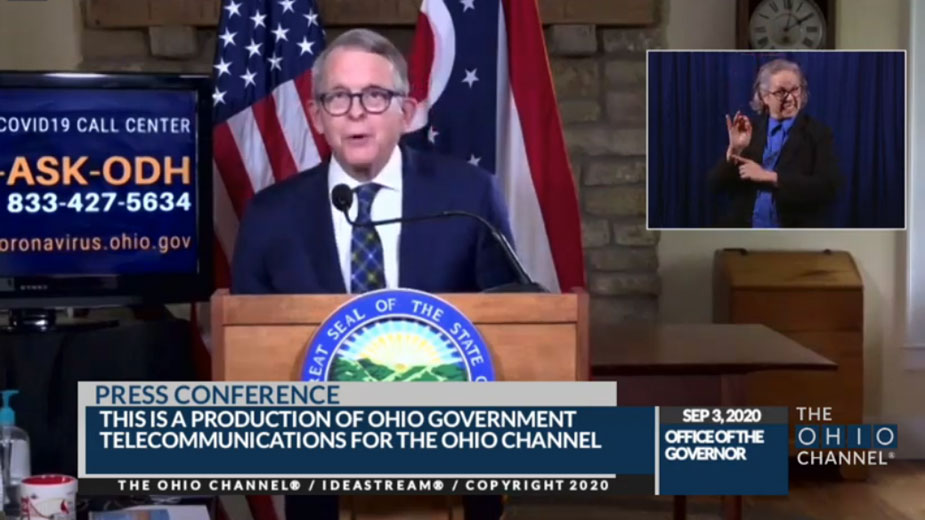DeWine Announces Coronavirus Wastewater Monitoring Network
YOUNGSTOWN, Ohio — To give communities another tool for early detection of COVID-19, Gov. Mike DeWine announced the launch of the Ohio Coronavirus Wastewater Monitoring Network.
Currently, 22 active sites comprise the network, which is a collaborative effort between the Ohio Department of Health, Ohio Environmental Protection Agency, the U.S. EPA, the Ohio Water Resources Center at the Ohio State University and other participating universities, including the University of Toledo, Kent State University and the University of Akron.
In addition to major metros throughout the state, the network includes the Youngstown Wastewater Treatment Plant and Warren Water Pollution Control Department. Researchers will study wastewater at network sites to help contain the spread of COVID-19, the disease spread by the coronavirus.
“The system will provide us with early warning signs of possible COVID-19 cases increase in an given community where that testing is being done,” DeWine said during Thursday’s coronavirus briefing. “It will also allow decision makers to move quickly to implement a plan to deal with it.”
Researchers will look for gene copies or fragments of noninfectious RNA, which can be found in the waste from infected people, both those who have symptoms and those who do not, the governor said. Such RNA can be detected in wastewater as many as three to seven days before those infections can lead to increased case counts or hospitalizations for the virus, giving communities advance warning of a potential outbreak.
In addition to assisting communities with taking precautions, the information can help the state alert its health care partners about a potential uptick in cases, monitor case data and intervene in potential hot spots, he said.
The announcement Thursday comes as the state records 1,345 more cases in 24 hours, as well as 50 deaths related to COVID-19 – the highest number of deaths reported by the health department in a single day since June.
On a positive note, the governor announced that 39 counties are ranked yellow on the state’s Public Health Advisory System, the most since July 2. Currently, 29% of Ohioans live in a yellow county.
DeWine reiterated caution for the upcoming Labor Day weekend, saying that while the state has seen “great tragedy” in the number of Ohioans who have been hospitalized and others who have died, “the fact still remains that Ohioans have done pretty well throughout this in stepping up.” He pleaded with viewers to stay safe so as to not replicate the spike in cases that were seen after the Fourth of July.
“What we do this weekend will really determine what our fall is going to look like,” he said.
In other news, DeWine said an order will be signed today requiring schools to report positive cases for COVID-19 to their respective local health departments. Under the order, which goes into effect Sept. 8, parents are required to notify schools within 24 hours of a positive test or clinical diagnosis of a student. Schools are then encouraged to notify parents of positive cases and must make information of cases available to the public on the state’s coronavirus website.
“Most schools are already doing this,” DeWine said.
Beginning Sept. 15, local health departments will have to report the number of newly reported and cumulative cases to the Ohio Department of Health every Tuesday. ODH will in turn report this information by school or school district, including a breakdown by students and staff every Thursday.
Schools will also need to identify a COVID-19 Coorindator to facilitate the reporting of case information, DeWine said. They will also need to have a pandemic plan in place to provide to local health departments upon request.
“We do not intend for protected health information to be released in our efforts to provide information to Ohioans,” he said.
Lt. Gov. Jon Husted reported this year, Ohio ranked No. 2 in aerospace manufacturing attractiveness for its tax policy and infrastructure. In addition, the U.S. Dept. of Defense designated Ohio one of six states as a defense manufacturing community.
The designation indicates long-term community investment in strengthening national security innovation and expanding the state’s capability of defense manufacturing, Husted said.
“It’s really important for our economy because we know how much of our economy relies on aerospace manufacturing,” he said. “This really is a signal to innovators, contractors and businesses that Ohio, as it’s seen through the Department of Defense, is a great place to invest. And this puts us is a position to secure more federal dollars … to help manufacturers invest in modernizing their manufacturing process and also upskilling their workforce.”
Gov. DeWine announced the Federal Emergency Management Agency is sending 9 million face masks in the next few weeks, following a donation of 2 million masks in early August.
Of the total masks, 4 million will be distributed to educational service centers to be sent to schools, 144,000 masks will go to the Ohio Department of Job and Family Services to be distributed to daycare centers, 2 million will go to programs and organizations that help underserved individuals, 1 million will go to high education institutions in the state and the remainder will be stored until needed.
Copyright 2024 The Business Journal, Youngstown, Ohio.



